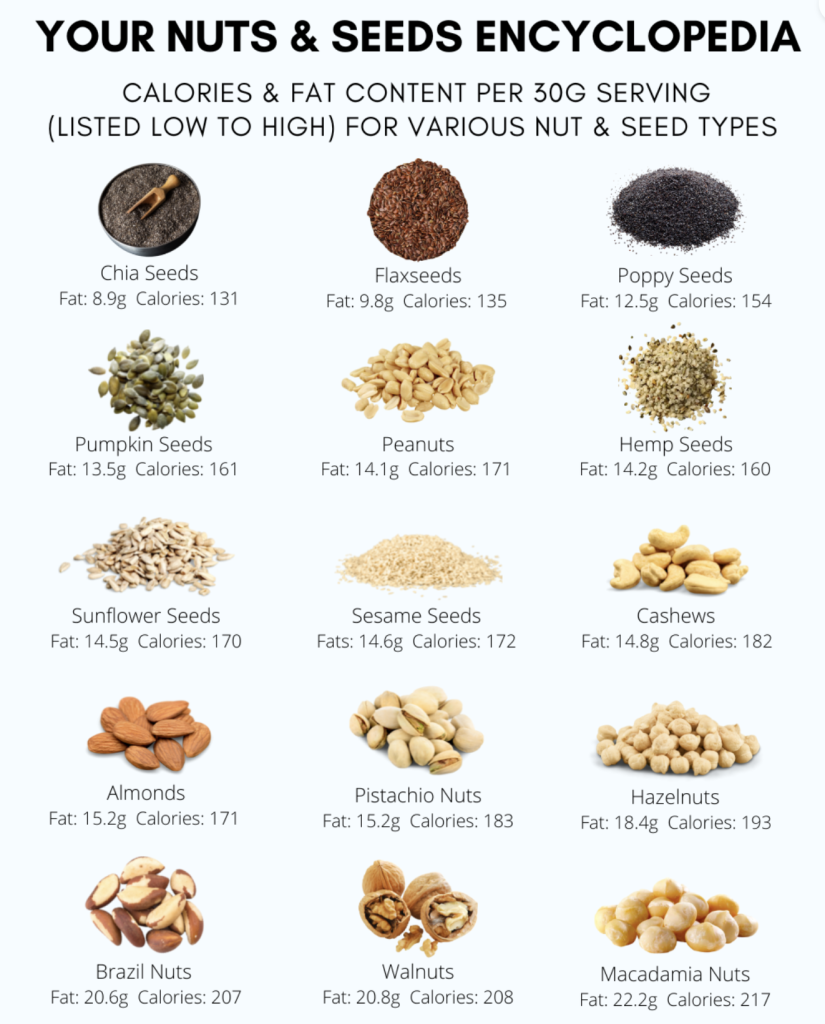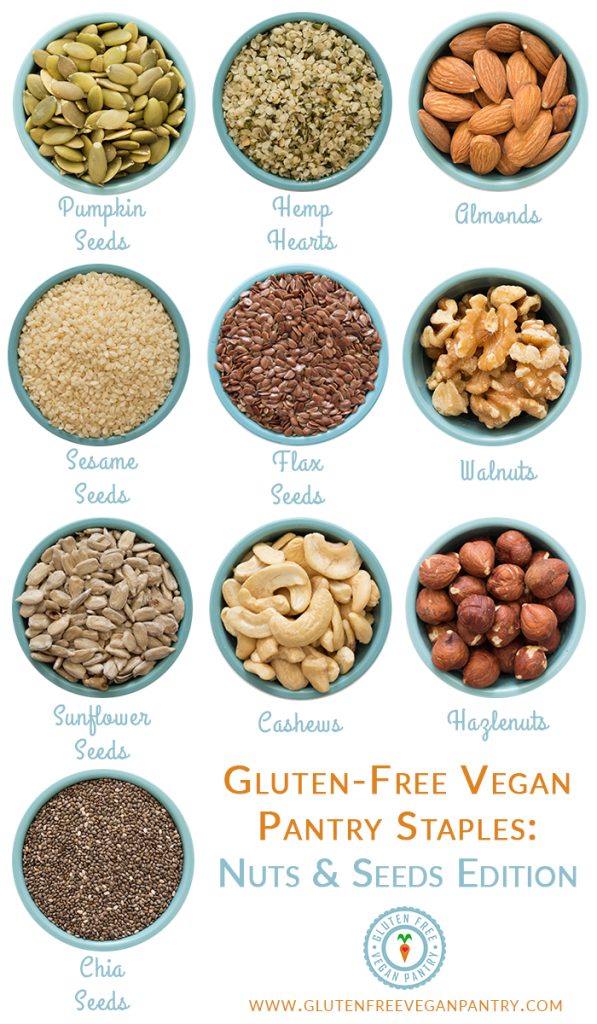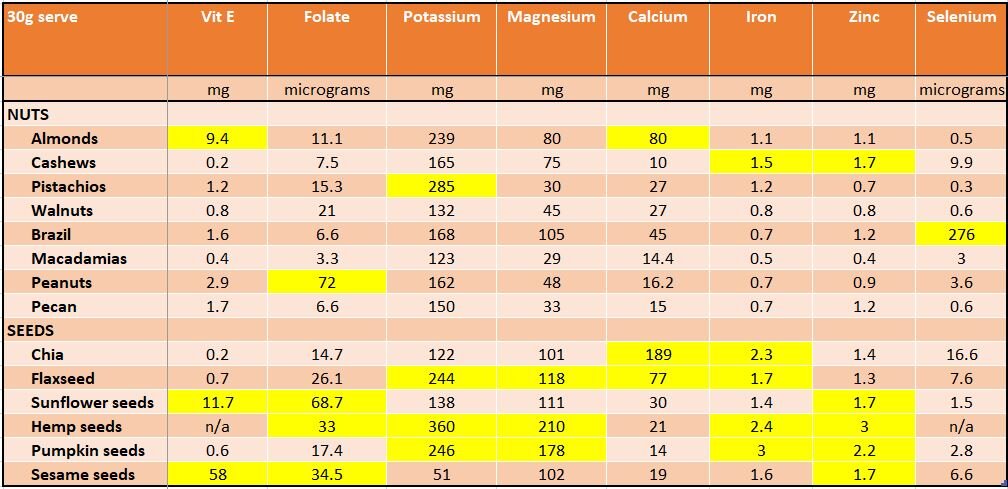
Nuts and seeds are both plant-based foods that offer numerous health benefits, but they have distinct differences in terms of their botanical classification, nutritional content, and uses.
Nuts
Definition: Nuts are hard-shelled fruits with a seed inside. They are generally derived from trees.
Examples: Almonds, walnuts, cashews, hazelnuts, pistachios, pecans.
Botanical Classification: True nuts include chestnuts, acorns, and hazelnuts. However, in culinary terms, many other seeds are also referred to as nuts (e.g., almonds, cashews).
Nutritional Content:
- High in healthy fats (mostly monounsaturated and polyunsaturated fats)
- Good source of protein
- Contains fiber, vitamins (especially vitamin E), and minerals (such as magnesium and potassium)
- Often higher in fat and calories compared to seeds
Uses: Eaten raw or roasted, used in cooking and baking, made into nut butters, added to salads, granola, and various dishes.
Seeds
Definition: Seeds are the small, embryonic plants enclosed in a covering called the seed coat, usually with some stored food.
Examples: Chia seeds, flaxseeds, pumpkin seeds, sunflower seeds, sesame seeds, hemp seeds.
Botanical Classification: Seeds are the reproductive part of a plant that can grow into a new plant.
Nutritional Content:
- Rich in healthy fats (especially omega-3 fatty acids in some seeds like chia and flaxseeds)
- Good source of protein
- High in fiber
- Contains vitamins (such as vitamin E and B vitamins) and minerals (such as magnesium, zinc, and iron)
- Often higher in fiber compared to nuts
Uses: Eaten raw or roasted, used in cooking and baking, added to smoothies, yogurt, salads, and cereals, made into seed butters or oils.
Summary
- Nuts: Hard-shelled fruits, often higher in fat and calories, good source of protein and healthy fats.
- Seeds: Embryonic plants, generally higher in fiber, also a good source of protein and healthy fats, often rich in omega-3 fatty acids.
Both nuts and seeds are nutrient-dense foods that can be a healthy addition to a balanced diet.

Some common nuts and their nutritional values per 100 grams:
Here’s a table listing some common nuts and their nutritional values per 100 grams:
| Nut | Calories (kcal) | Protein (g) | Fat (g) | Carbohydrates (g) | Fiber (g) | Vitamin E (mg) | Magnesium (mg) |
|---|---|---|---|---|---|---|---|
| Almonds | 579 | 21.2 | 49.9 | 21.6 | 12.5 | 25.6 | 270 |
| Walnuts | 654 | 15.2 | 65.2 | 13.7 | 6.7 | 0.7 | 158 |
| Cashews | 553 | 18.2 | 43.8 | 30.2 | 3.3 | 0.9 | 292 |
| Pecans | 691 | 9.2 | 72.0 | 13.9 | 9.6 | 1.4 | 121 |
| Hazelnuts | 628 | 15.0 | 60.8 | 16.7 | 9.7 | 15.0 | 163 |
| Pistachios | 562 | 20.2 | 45.4 | 27.2 | 10.6 | 2.9 | 121 |
| Brazil Nuts | 659 | 14.3 | 67.1 | 11.7 | 7.5 | 5.7 | 376 |
| Macadamia | 718 | 7.9 | 75.8 | 13.8 | 8.6 | 0.5 | 130 |
This table includes the calorie content, protein, fat, carbohydrates, fiber, vitamin E, and magnesium levels for each type of nut. These values can vary slightly based on the source and specific variety of nut, but they provide a good general overview.
Some common seeds and their nutritional values per 100 grams:
| Seed | Calories (kcal) | Protein (g) | Fat (g) | Saturated Fat (g) | Carbohydrates (g) | Fiber (g) | Calcium (mg) | Iron (mg) | Magnesium (mg) |
|---|---|---|---|---|---|---|---|---|---|
| Chia Seeds | 486 | 16.5 | 30.7 | 3.3 | 42.1 | 34.4 | 631 | 7.7 | 335 |
| Flaxseeds | 534 | 18.3 | 42.2 | 3.7 | 28.9 | 27.3 | 255 | 5.7 | 392 |
| Sunflower Seeds | 584 | 20.8 | 51.5 | 4.5 | 20 | 8.6 | 78 | 5.0 | 325 |
| Pumpkin Seeds | 446 | 18.6 | 19.4 | 3.1 | 53.8 | 18.4 | 46 | 8.8 | 592 |
| Sesame Seeds | 573 | 17 | 49.7 | 6.7 | 23.5 | 11.8 | 975 | 14.6 | 351 |
| Hemp Seeds | 553 | 31.6 | 48.8 | 4.6 | 8.7 | 4.0 | 70 | 7.9 | 700 |
| Poppy Seeds | 525 | 18.7 | 41.6 | 4.4 | 28.1 | 19.5 | 1438 | 9.8 | 347 |
| Cucumber Seeds | 16 | 1 | 0.1 | – | 3.6 | 0.5 | 17 | 0.3 | 14 |
| Watermelon Seeds | 557 | 28.4 | 47.4 | 6.7 | 16.5 | 8.3 | 55 | 4.6 | 515 |
This table includes the calorie content, protein, fat, carbohydrates, fiber, vitamin E, magnesium, and omega-3 fatty acids levels for each type of seed. These values can vary slightly based on the source and specific variety of seed, but they provide a good general overview.

| Seed | Calories (kcal) | Protein (g) | Fat (g) | Saturated Fat (g) | Carbohydrates (g) | Fiber (g) | Calcium (mg) | Iron (mg) | Magnesium (mg) |
|---|---|---|---|---|---|---|---|---|---|
| Chia Seeds | 486 | 16.5 | 30.7 | 3.3 | 42.1 | 34.4 | 631 | 7.7 | 335 |
| Flaxseeds | 534 | 18.3 | 42.2 | 3.7 | 28.9 | 27.3 | 255 | 5.7 | 392 |
| Sunflower Seeds | 584 | 20.8 | 51.5 | 4.5 | 20 | 8.6 | 78 | 5.0 | 325 |
| Pumpkin Seeds | 446 | 18.6 | 19.4 | 3.1 | 53.8 | 18.4 | 46 | 8.8 | 592 |
| Sesame Seeds | 573 | 17 | 49.7 | 6.7 | 23.5 | 11.8 | 975 | 14.6 | 351 |
| Hemp Seeds | 553 | 31.6 | 48.8 | 4.6 | 8.7 | 4.0 | 70 | 7.9 | 700 |
| Poppy Seeds | 525 | 18.7 | 41.6 | 4.4 | 28.1 | 19.5 | 1438 | 9.8 | 347 |
| Cucumber Seeds | 16 | 1 | 0.1 | – | 3.6 | 0.5 | 17 | 0.3 | 14 |
| Watermelon Seeds | 557 | 28.4 | 47.4 | 6.7 | 16.5 | 8.3 | 55 | 4.6 | 515 |
Here’s a list of common seeds and their nutritional values (per 100 grams):
1. Chia Seeds
- Calories: 486 kcal
- Protein: 16.5 g
- Fat: 30.7 g
- Saturated fat: 3.3 g
- Carbohydrates: 42.1 g
- Fiber: 34.4 g
- Calcium: 631 mg
- Iron: 7.7 mg
- Magnesium: 335 mg
2. Flaxseeds
- Calories: 534 kcal
- Protein: 18.3 g
- Fat: 42.2 g
- Saturated fat: 3.7 g
- Carbohydrates: 28.9 g
- Fiber: 27.3 g
- Calcium: 255 mg
- Iron: 5.7 mg
- Magnesium: 392 mg
3. Sunflower Seeds
- Calories: 584 kcal
- Protein: 20.8 g
- Fat: 51.5 g
- Saturated fat: 4.5 g
- Carbohydrates: 20 g
- Fiber: 8.6 g
- Calcium: 78 mg
- Iron: 5.0 mg
- Magnesium: 325 mg
4. Pumpkin Seeds
- Calories: 446 kcal
- Protein: 18.6 g
- Fat: 19.4 g
- Saturated fat: 3.1 g
- Carbohydrates: 53.8 g
- Fiber: 18.4 g
- Calcium: 46 mg
- Iron: 8.8 mg
- Magnesium: 592 mg
5. Sesame Seeds
- Calories: 573 kcal
- Protein: 17 g
- Fat: 49.7 g
- Saturated fat: 6.7 g
- Carbohydrates: 23.5 g
- Fiber: 11.8 g
- Calcium: 975 mg
- Iron: 14.6 mg
- Magnesium: 351 mg
6. Hemp Seeds
- Calories: 553 kcal
- Protein: 31.6 g
- Fat: 48.8 g
- Saturated fat: 4.6 g
- Carbohydrates: 8.7 g
- Fiber: 4.0 g
- Calcium: 70 mg
- Iron: 7.9 mg
- Magnesium: 700 mg
7. Poppy Seeds
- Calories: 525 kcal
- Protein: 18.7 g
- Fat: 41.6 g
- Saturated fat: 4.4 g
- Carbohydrates: 28.1 g
- Fiber: 19.5 g
- Calcium: 1438 mg
- Iron: 9.8 mg
- Magnesium: 347 mg
8. Cucumber Seeds
- Calories: 16 kcal
- Protein: 1 g
- Fat: 0.1 g
- Carbohydrates: 3.6 g
- Fiber: 0.5 g
- Calcium: 17 mg
- Iron: 0.3 mg
- Magnesium: 14 mg
9. Watermelon Seeds
- Calories: 557 kcal
- Protein: 28.4 g
- Fat: 47.4 g
- Saturated fat: 6.7 g
- Carbohydrates: 16.5 g
- Fiber: 8.3 g
- Calcium: 55 mg
- Iron: 4.6 mg
- Magnesium: 515 mg
These values may vary slightly depending on the source and variety of seeds. Let me know if you’d like additional details or breakdowns on other seeds!
How to take each of these Seeds for maxium body obserbations
| Seed | How to Consume | Best Time to Take |
|---|---|---|
| Chia Seeds | – Soak 1-2 tbsp in water or milk for 15-20 minutes.- Add to smoothies, yogurt, or baked goods. | Morning or pre-workout snack. |
| Flaxseeds | – Ground before consumption.- Add to smoothies, oatmeal, yogurt, or baking. | Morning or throughout the day. |
| Sunflower Seeds | – Eat raw or roasted (unsalted).- Add to salads, yogurt, or trail mixes. | Mid-afternoon snack. |
| Pumpkin Seeds | – Eat raw or roasted.- Add to smoothies, salads, or baked goods. | Snack or part of meals (salads, soups). |
| Sesame Seeds | – Ground or whole.- Use tahini in spreads, dips, or dressings.- Add to salads or stir-fries. | Use throughout the day in meals or snacks. |
| Hemp Seeds | – Consume raw (1-2 tbsp).- Add to smoothies, yogurt, oatmeal, or cereal.- Can also use in hemp milk. | Breakfast or post-workout. |
| Poppy Seeds | – Ground for better absorption.- Add to baked goods or as a topping for salads or yogurt. | Throughout the day in baked goods or toppings. |
| Cucumber Seeds | – Eat raw.- Add to salads or blend in smoothies. | Part of meals, especially in salads or smoothies. |
| Watermelon Seeds | – Roast at low temperatures.- Eat raw or ground in smoothies, baked goods, or as a snack. | Snack or added to meals throughout the day. |
To gain maximum benefits from seeds, it’s important to consider the optimal way of consuming them. Each type of seed offers unique health benefits, so consuming them in various ways can enhance their absorption and effectiveness. Here’s a guide on how to take each seed for maximum benefits:
1. Chia Seeds
- How to Consume:
- Soaked in Water or Milk: Soak 1-2 tablespoons of chia seeds in 1 cup of water or milk for about 15-20 minutes before eating. This helps increase their size and improves digestion.
- Smoothies: Add soaked chia seeds to smoothies.
- Baking: Add them to muffin, bread, or pancake batter.
- Best Time to Take: In the morning or as a pre-workout snack.
2. Flaxseeds
- How to Consume:
- Ground Flaxseeds: Flaxseeds should be ground before consuming, as whole seeds pass through the digestive system undigested.
- Add to Smoothies, Yogurt, or Oatmeal: Mix ground flaxseeds into your daily smoothie, yogurt, or oatmeal.
- Baking: Add ground flaxseeds to baked goods for extra fiber.
- Best Time to Take: Morning or as an addition to snacks throughout the day.
3. Sunflower Seeds
- How to Consume:
- Roasted or Raw: You can eat sunflower seeds raw or roasted. If roasted, ensure they are not salted.
- Sprinkled on Salads: Add them as a crunchy topping to salads.
- In Snacks: Mix them with nuts or add them to trail mixes.
- Best Time to Take: Any time during the day, but as a mid-afternoon snack they provide a good energy boost.
4. Pumpkin Seeds
- How to Consume:
- Raw or Roasted: Eat them raw or roasted as a snack.
- In Smoothies: Add pumpkin seeds to smoothies for extra protein and healthy fats.
- In Salads: Sprinkle on top of salads or soups.
- In Baking: Incorporate into muffins, bread, or cookies.
- Best Time to Take: As a snack or added to meals like salads or soups.
5. Sesame Seeds
- How to Consume:
- Ground or Whole: Use both ground sesame seeds (tahini) or whole seeds.
- Tahini: Spread tahini (ground sesame) on toast or use in dips and dressings.
- In Salads or Stir-fries: Sprinkle sesame seeds on top of salads or stir-fries for crunch and added flavor.
- Baking: Add them to baked goods, such as bread or muffins.
- Best Time to Take: Use throughout the day, especially in snacks or as toppings on meals.
6. Hemp Seeds
- How to Consume:
- Raw: Hemp seeds are best consumed raw to preserve their nutrients. Add 1-2 tablespoons to smoothies, salads, or yogurt.
- Sprinkled on Oatmeal or Cereal: Sprinkle hemp seeds on top of oatmeal, cereal, or yogurt.
- Hemp Milk: Use in smoothies or for baking.
- Best Time to Take: They are excellent for breakfast or a post-workout meal due to their high protein content.
7. Poppy Seeds
- How to Consume:
- Ground: Poppy seeds are best consumed ground for better nutrient absorption.
- In Baking: Add to cakes, muffins, or bread.
- As a Topping: Sprinkle on top of salads, vegetables, or yogurt.
- Best Time to Take: Use throughout the day in baked goods or as a topping for snacks.
8. Cucumber Seeds
- How to Consume:
- Raw: Cucumber seeds are soft and can be eaten raw in salads or smoothies.
- Blended in Smoothies: Blend cucumber seeds with fruits and vegetables for a refreshing smoothie.
- Best Time to Take: Typically eaten as part of a salad or smoothie, great for hydration.
9. Watermelon Seeds
- How to Consume:
- Roasted: Roast watermelon seeds for a crunchy snack. Just dry them out and roast at a low temperature for about 10-15 minutes.
- Raw: Can also be eaten raw in smoothies, salads, or as a snack.
- Ground: Ground seeds can be added to baking mixes or smoothies.
- Best Time to Take: As a snack or added to meals throughout the day.
General Tips for Maximum Absorption:
- Soaking/Grinding: Soaking seeds like chia, flax, and watermelon before consuming increases nutrient absorption and digestion.
- Avoid Overheating: Roasting seeds at high temperatures can degrade certain nutrients. Opt for lower roasting temperatures or enjoy seeds raw.
- Combine with Healthy Fats: For enhanced absorption of fat-soluble vitamins, pair seeds with healthy fats such as olive oil, avocado, or coconut oil.
- Moderation: While seeds are highly nutritious, they are also calorie-dense, so portion control is important.